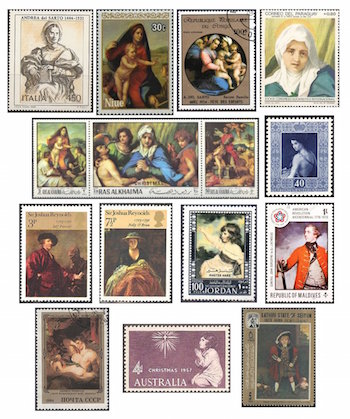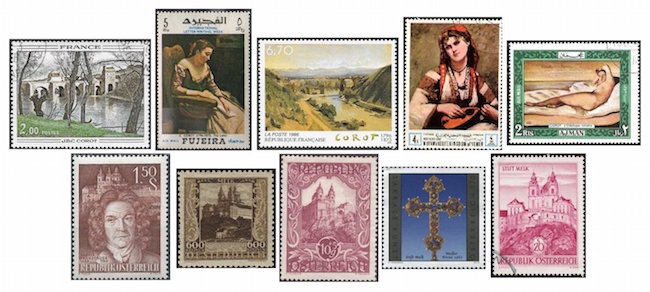The Arts on Stamps of the World — July 16
An Arts Fuse regular feature: the arts on stamps of the world.

By Doug Briscoe
Three great painters— Andrea del Sarto, Sir Joshua Reynolds, and Camille Corot—start us off today, though we have nothing like the plenitude of stamps that we saw for Rembrandt yesterday. Other top names on this July 16th include Eugène Ysaÿe and Ginger Rogers.

The Florentine painter Andrea d’Agnolo di Francesco di Luca di Paolo del Migliore (16 July 1486 – before 29 September 1530) came to be known as Andrea del Sarto because his father was a tailor (Italian: sarto). His life inspired a play (1848) by Alfred de Musset, a poem (1855) by Robert Browning, and an opera (1968) by Jean-Yves Daniel-Lesur. Now to the stamps: the Italian one at upper left is a copy of Study of a Woman (c1517–25). Next to that, from Niue—and on the leftmost panel of the Ras al Khaima triptych, too—is the Virgin of the Stairs (Madonna della Scala, 1522). From the Congo comes Holy Family, a work attributed to the school of del Sarto, with, I’m pretty sure, the image reversed). Appearing on the Paraguayan issue and the centerpiece of the Ras al Kahiama troika is Lamentation of Christ ( c1520), with the right panel being The Sacrifice of Isaac (c1522). Finally comes Saint John the Baptist (c1520) in a stamp of Liechtenstein, where the painting is currently housed.
For the eighteenth-century English portrait painter Sir Joshua Reynolds (16 July 1723 – 23 February 1792), member of the famous Club that included Samuel Johnson, Oliver Goldsmith, Edmund Burke, and David Garrick, we have a further seven stamps. First up is one of his self-portraits, this one from c1780. Then, from the same British set of stamps comes Miss Nelly O’Brien (1762-64). On a Jordanian stamp is Master Hare (1789), and the row ends with a portrait of General John Burgoyne (c1766) on a Maldivian issue. The second row begins with Cupid Untying the Girdle of Venus (1788); the model for the goddess may have been Lord Nelson’s mistress Lady Hamilton. The Australian Christmas stamp from 1957 takes Reynolds’s Infant Samuel (1776) as its source, and finally, the charming Master Crewe as Henry VIII (c1775) is reproduced on a stamp from one of the Arabian States, the Kathiri State of Seiyun.

Our five offerings for Jean-Baptiste-Camille Corot (July 16, 1796 – February 22, 1875) include The Bridge at Mantes (c1868-70), The Letter (c1865), The Bridge at Narni (1826), Girl with a Mandolin (1860-65), and The Roman Odalisque (1843). Though he did earn a scholarship to study art in Rouen, Corot won no awards, but an allowance from his parents permitted him to devote himself to art anyway. There were honors (the Légion d’honneur in 1847) and acceptance in middle life, but it was only in his later years that he began to achieve broad recognition. By the 1860s his canvases were selling before the paint was dry, and he made a small fortune, with which he was very generous.
The precise birth date of Austrian Baroque architect Jakob Prandtauer is unknown. He was baptized on this date in 1660. His first buildings date from the 1690s. His grandest work, begun in 1702, is the splendid Melk Abbey, though he did not live to see its completion in 1736, having died a decade earlier in Sankt Pölten on 16 September 1726. You can make out the abbey behind the head of the architect on his portrait stamp, and it is front and center on three of the other stamps, the first of which, the brown “600 kronen” value, dates from 1923. The stamps, pretty as they are, cannot do justice to the magnificence of the structure. Though it has no direct connection to Prandtauer, I also added a stamp showing a 14th-century cross that is one of the abbey’s treasures. Prandtauer’s image appeared on an old Austrian 50 Schilling banknote from 1951.
From the same generation was the Czech (Slovakian) portrait painter Jan Kupecký (or Johann Kupetzky), who was born in 1667. He spent 22 years living in Italy, but little is known of his activities there. In Vienna, despite his Protestantism, he received court commissions, one of his subjects being Prince Eugene of Savoy. Yet, he was apprehensive enough of persecution that he took his family to Nuremberg in 1733, where he died on this date seven years later. The Czech stamp displays his self-portrait with his family, dated 1719.
July 16 is the birthday of the great Belgian violinist Eugène Ysaÿe (ee-za-ee; 1858 – 12 May 1931). He was also a composer, mainly of music for his own instrument, most notably his six solo sonatas of 1923, but also chamber works (a string quartet, a string quintet, two piano trios, etc.) and an opera. Besides his extensive touring of Europe and the US, he was a teacher whose pupils included Josef Gingold, Nathan Milstein, Oscar Shumsky, and the violist William Primrose. (He himself had studied with Wieniawski, whose birthday was last week, and Vieuxtemps.) Chausson’s Poème was written at Ysaÿe’s request, and César Franck wrote his great Violin Sonata as a wedding present. In 1886, he founded the Ysaÿe Quartet, which gave the première of Debussy’s masterpiece in the form. That work and many others by composers such as Saint-Saëns and Fauré were dedicated to Ysaÿe. He was a friend of Queen Elisabeth of Belgium (whose birthday is coming up in nine days). He gave her violin lessons over many years. After he died, she created a violin competition in his memory, but since 1951 it has been called the Queen Elisabeth Music Competition (more details on July 25). Ysaÿe’s playing can be heard in the 16 recordings he made between 1912 and 1916, and he also left a half-dozen recordings as conductor of the Cincinnati Symphony Orchestra (of which he was music director from 1918 to 1922), all made on a November day in 1919. He has just this one stamp in his honor.

The photography of American painter Charles Sheeler (July 16, 1883 – May 7, 1965) is not represented on stamps, but two of his paintings are. Commercial photography was Sheeler’s primary source of income, and his work in that area has come to be held in the same regard as that of other masters of the medium. Philadelphia-born, Sheeler went to Italy and Paris and was struck by the new Cubist movement, but realized he couldn’t make a living with it back home. Instead, he did the next best thing and painted industrial and mechanistic subjects in a realist and precisionist manner. The 1998 issue gives us his Two Against the White (1957), and the one from 2013 his American Landscape (1930). This latter work was one of the pieces resulting from a 1927 commission to photograph and paint Ford Motor Company factories. A goodly number of Sheeler’s canvases and photos are in the collection of Boston’s Museum of Fine Arts; one of them is New England Irrelevancies (1953).
Ginger Rogers (born Virginia Katherine McMath; July 16, 1911 – April 25, 1995) came from Independence, Missouri and adopted the name of her step-father. She ended up in Hollywood because her mother aspired to be a scriptwriter (and made it!), though Rogers’s beginnings were on the stage. She first acted in films in 1929. From 1933 to 1939 she made nine musicals with Fred Astaire for RKO Pictures. (One of these, incidentally, was Swing Time, the lyrics for which were written by yesterday’s birthday girl Dorothy Fields.) Rogers won a Best Actor Oscar for her performance in Kitty Foyle (1940). She was married five times and was a lifelong Republican and Christian Scientist. Her memoir, Backwards in High Heels, was made into a musical in 2007.
Portuguese writer, painter, and critic Mário Dionísio (16 July 1916 – 17 November 1993) was born and died in Lisbon. He wrote poetry and fiction, besides being a teacher. He turned to painting only in 1941, working under the pseudonyms Leandro Gil and José Alfredo Chaves. Since the stamp shows none of his art, I will. Here’s The Musician (1948).
American science fiction writer Robert Sheckley (July 17, 1928 – December 9, 2005) was one of the relatively few in the field to write with a comic bent. Born in Brooklyn, he sold his first story in 1951. Before the decade was out he was being praised by such figures as Kingsley Amis. His 1953 story “Seventh Victim” was made into an Italian movie The 10th Victim (La decima vittima, 1965) with Marcello Mastroianni and Ursula Andress. Sheckley also wrote mysteries and fantasy fiction. The stamp come from a 1998 sheet from San Marino given over to titles (most of them made into films) by science fiction writers. I wish I’d known about it on Robert A. Heinlein’s birthday nine days ago. Since I missed it, I thought I may as well include it now—the stamp cites Heinlein and his most famous novel Stranger in a Strange Land.
July 16 is also the date on which Mozart’s Abduction from the Seraglio was given its première in 1782 at the Vienna Burgtheater, with Mozart himself conducting. The French stamp comes from a set recalling costumes from Mozart operas. Abduction is the German-language opera Tom Hulce pleaded with Jeffrey Jones to support, while F. Murray Abraham demurred, scowling. So, there it is.
Today would have been the 89th birthday of the wonderful English novelist Anita Brookner had she not passed away on March 10th last year.
A graduate of the University of Massachusetts with a B.A. in English, Doug Briscoe worked in Boston classical music radio, at WCRB, WGBH, and WBUR, for about 25 years, beginning in 1977. He has the curious distinction of having succeeded Robert J. Lurtsema twice, first as host of WGBH’s weekday morning classical music program in 1993, then as host of the weekend program when Robert J.’s health failed in 2000. Doug also wrote liner notes for several of the late Gunther Schuller’s GM Recordings releases as well as program notes for the Boston Classical Orchestra. For the past few years he’s been posting a Facebook “blog” of classical music on stamps of the world, which has now been expanded to encompass all the arts for The Arts Fuse.
